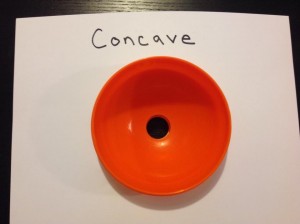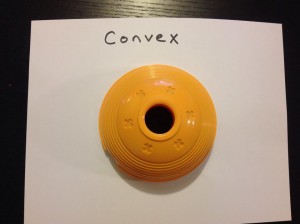I have been working towards developing tangible materials to teach science and engineering terms to my preschooler. No, I am not breaking out the free body diagrams for my 3 year old yet. But I am focused on building a strong vocabulary of many science and engineering related terms, borrowing principles from Maria Montessori to do it.
The reason for doing it at this age is, first, to do this when my children have an “absorbent mind” and learn new words easily. The second reason however is deeper than that: It’s so my children start to observe the properties of the world as each attribute is brought to their attention, which is why I am focused on science and engineering, as these make up the fundamental components of the world. Lemme ‘splain …
In the Montessori method, and this is one of the best geniuses of it, in my opinion, concepts are taught in an organized, reality-based way. Concepts are taught with materials that isolate the concept (the word) being taught. For instance, if teaching color, color tablets, which are completely identical except different in color, are presented. After some matching games, which draw the child’s attention to this attribute, the teacher simply says, “This is blue,” pointing to the blue tablet and “This is red,” pointing to the red tablet. It is clear and obvious what the teacher means. It is a very simple lesson–and powerfully effective.
The result of this, and the other genius of the Montessori system is, after being given such lessons, the child is then sensitive to seeing such attributes in the reality around them. When my son was just older than 2, I took two knobbed cylinders, identical except that one was short, and one was tall, and, after he had played with the cylinders, I put the two side by side and said, “This one is short. This one is tall.” I did this but once. I was stunned when, about three weeks later, he saw two trees side by side, and told me, “Mommy, that one is short. This one is tall.” He was completely right. I had only given him that lesson once.
I think this can be taken further: with words that make up the fundamental components of all things, which means many science and engineering terms. So far I have developed material for teaching the following words: transparent vs opaque; concave vs convex; flex vs extend; and “insulation.” I also have plans to teach things like hard vs soft; low vs high “pressure” (Montessori materials are already in place for this); and a lot more. My husband is a brilliant mechanical design engineer and we plan on making materials to teach geometric dimensioning: the very attributes that engineers mark on a blue print to dictate how to manufacture the product: size, position, circularity, etc. Imagine a child looking at a mechanical product and noticing the features of it, i.e., reverse engineering it.
Already these lessons have proven useful. My son spontaneously demonstrates an understanding of concave and convex often. For instance, he bent a pillow once and said, “This side is concave!” “This side is convex!” It helps with communication as well. He and I were in one car and my husband was in front of us in another car. My son kept asking, “Where’s daddy?” and I kept saying, “In the car in front of us.” It went on like this 5 or 6 times. Finally I said, “It sounds like you can’t see daddy.” He said, “No, mommy, you are opaque!” Ha. I sure am. (The endless questions stopped after that. )
In designing the lesson, first, all of the materials are tangible. When I made the lesson for insulation, I filled up a thermos (which insulates heat and cold) with cold water and another canister with the same cold water and let my son feel the difference. Ayn Rand writes in An Introduction to Objectivist Epistemology that most people don’t tie the concepts (the words) they use to their exact definition in reality. It’s my goal to use reality-based materials, which isolate the concept as best as possible in the footsteps of Montessori, to teach these words. It will also give practice to that “muscle” that is concept formation itself (the other great benefit of Montessori): to come to expect to look to reality to know exact definitions.
I try to isolate the concept as best as possible, but sometimes it is hard to have it completely isolated. For instance, in the insulation lesson, the thermos was green and tall while the canister was short, fat, and clear. However, my son already knows the differences in color, size, and even transparency, so I believe this was irrelevant. If I had never taught him colors, and he was feeling that one was cold and another one was not, he might be led to believe “Green things insulate cold and clear things do not.”
With the lessons I have found two things. 1.) It’s always good to have two activities to teach a concept. With the insulation lesson, I filled the thermos and cups up with cold water one day and for the next lesson, I filled them up with hot water. Something about having two lessons cements it–perhaps to really help distinguish the concept. 2.) Letting the child sleep overnight on the lesson helps them learn it. I have learned to present the lesson one day and save any questions (the assessment part to see if the knowledge was absorbed) for the next day. I have found this with every skill we’ve learned: Learn it one day, with no quizzes whatsoever, and try the skill out the next day.
By nature, these lessons are very simple. There is way too much clutter when it comes to teaching children this information. Montessori writes about how teachers spend a lot of time giving a lot of information, which is irrelevant to the child, who is unprepared to understand what is being said, and only confuses him or her. For instance, in Spontaneous Activity in Education, Montessori describes a teacher who gave a lesson on coffee to a Kindergarten class which included a lesson on, “its size, its color, its shape, its aroma, its flavor, its temperature; […] the manner in which the substance was brought to Europe across the ocean, and [many more things].” I can only imagine if the child was asked what is coffee after this lengthy explanation, they might reply, “I don’t know. It has something to do with a boat.” Compare this to simply pointing to the beverage and saying, “This is coffee.”
I want to add also that at no point do I force my child into the lessons. I don’t have to badger him. I never turn into a mean mom demanding my son learn things. Montessori advises that if a lesson isn’t going well, simply stop, and try again some other time. I find he loves hands-on learning and he especially loves doing “EXPERIMENTS!” (his word and level of enthusiasm).
To come up with the lessons, I look to many different resources. I especially have found value in reading science books geared towards children. Most science books are geared for children aged fourth grade or up. I read these books and look for new words to teach my child, and I come up with a new activity. Sometimes these books have activities that I think my 3 year old could do, or t least find fun, and I do those too. Follow me on facebook and Pinterest, as “The Observant Mom” for all of the activities that I do.



2 thoughts on “My Goal in Teaching Science and Engineering Terms to Preschoolers”